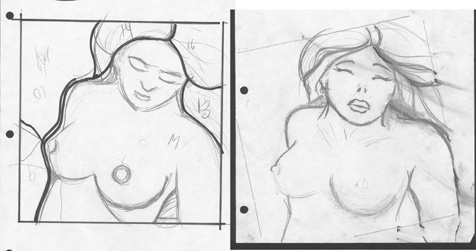
millenniumartglass.com
Millennium Art Glass Company
(A division of fruitcratelabels.com)
15) PETER McGRAIN'S TRADEMARKED "VITRI-FUSAILLE"® METHOD
("vit-tree-few-sigh") That's French!
As I mentioned before, during the course of my training with Peter McGrain, he introduced me to a form of glass work that was new and exciting, and something he developed and registered a trade-name for. I won't go into the entire process, but I will show quickly, how I did one of my pieces with Peter, and how liberating it was to learn to do. For more on this technique (and those that surround it), you should contact Peter for his DVD on the subject, then take his training! You should also learn about System 96 fusable glass from Spectrum and Uroboros.
The idea is basically the same as doing most stained glass art. You cut a number of different colored pieces of glass, and assemble them into a jig-saw type design. Now, normally, IF, you plan to do any painting on this "window", you need to lay out all the pieces, then paint and fire them individually, as many times as it takes to get the desired image, and then you foil or lead them into a finished window. However, in this method, the way to circumvent all that lead and copper work, and to limit painting and firing a lot of small individual pieces, is to fuse the colored glass into one piece of glass, then paint and fire it as ONE piece of glass.

In Peter's method, one starts by taking a design-sketch and makes a traceline sketch or cartoon. Then, just as in stained glass work, you cut the individual pieces of glass out and lay them on the cartoon. You want as tight an edge as possible, and NO grinding, just cut, plink, groze, place and fuse.
One main difference in this method, is that ALL THE GLASS MUST BE FUSABLE WITH ITSELF. For many reasons, not all glass is the same. Most stained glass in stores, studios (my shop!), and elsewhere was made in different decades, by different manufacturesr, of different materials, through different means, etc. They ALL expand, melt, cool and contract in different ways and at different rates. That means, if you put different types of incompatible glass together that have different expansion rates (fusing co-efficients or COE), and try to fuse them together, they will crack, break or fail to fuse. In some cases they don't fail for days or months, so one day in the sunlight the piece simply shatters. However, several years ago System 90 was developed, so that a wide pallat of colors of compatible glass could all be fused together successfully, because they all had the same fusing coefficient, or 90 COE. This was called system 90, developed by Bullseye. But, today, recent advancements and a symbiotic relationship between Spectrum and Uroboros, have given glass artists a BIGGER, better pallat of fusable glass colors, styles and products, called System 96. This means, an -ever-broadening pallat of glass colors can be successfully fused into one work with full compatibility!
NOTE: (If you do a VF piece with System 90, it mast ALL BE SYSTEM 90 AND ONLY SYSTEM 90. If you do a piece with System 96 IT MUST ALL BE SYSTEM 96. (You can use S90 for the borders and make those. Then make the main image with th S96 pallat. Then lead or copper foil the border to the main image. So both systems can be used in one piece, BUT NOT FUSED BETWEEN THE TWO SYSTEMS.)
So, Peter has taken this to a new level with his now-trademarked Vitri-Fusaille® method. You choose the System 96 compatible colors of glass and make up your design. Then you place all the pieces atop another layer of CLEAR System 96 Machine-rolled clear glass as a substrate upon which all the pieces sit. Then, you fuse them all together. Now, the System 96 glass is 1/8" thick. So, the colored pieces AND the substrate, when fused, are 1/4" thick and one solid fused mass sheet. In the pear example, there are nine pieces of glass sitting on a sheet of clear and fused. The tropical girl has six pieces of glass atop a layer of clear, AND, four small pices laid atop the colored pieces (a third layer, if you will), which melts down into the color-glass layer.
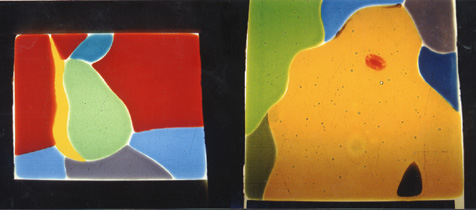
In the case of my two projects, a pear and a tropical girl, you can see how they look after their first firing. In the case of my Tropical Girl, we put a small piece of red where her lips are, some peach colored pices for her nipples and a green piece for her arm-pit, and during the fusing process, these sunk down into the colored glass layer. The red piece accidentally melted out wider than we thought, so it made her lips look like they were puckered. So, I changed my design to make the best of that. The nipples' color faded and they basically disappeared into the glass, barely visable in the upper photo. On Peter's version, he put a piece of green glass for the nipple, which turned out to be a very clever choice. The next day, we put the tracelines on three of the pieces and fired them as can be seen in the lower photo. At this point I stopped work on the pear, and focused on the tropical girl, instead.
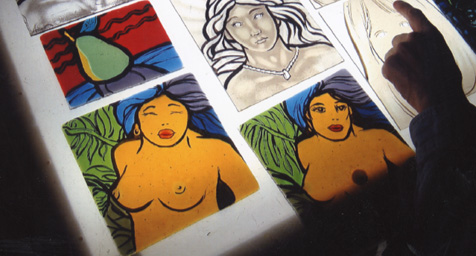
Each day, we contunied to paint and edited matte layers and refired them along with all our other work. In the next image, you can see the fully painted matte layer on the left (with a few "pulls" removed from the face), and then the edited matte where the selected paint has been removed to creat the illusion of shading. Then it was fired and we repeated the process several more times. Note that the whole piece is matted, then a good deal of the matte is removed, leaving only the deeper shading behind. This is how depth and dimensionality is created in all glass painting. BUT, in vitri-fusaille you paint ONE piece of multi-colored glass, not a lot of small pieces!
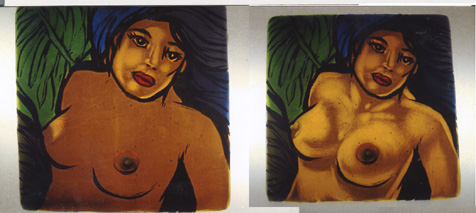
Finally, after four days, the finished fusaille pieces were done. Mine is on the left, and Peter's is seen in reverse, (laying face down on the light table) on the right. This shows the results of several matte layers. Note how under the breasts there are deep, medium and soft shadows of varying degrees of darkness, then a highlight on the top. That is from four matte layers being worked. Note, too, that in the first photo above, all the fusing lines can be seen between the pieces of glass, and here, NONE of the fuse lines can be seen. There is simplay a lot of high colors "popping out" next to very contrasting lines and other colors. The entire affect is one piece of finished glass with some painting on it. No copper foil, no lead lines. Now, you CAN make bigger windows, using many fussaille-created pieces and lead them together with 1/4 came, to make larger pieces. Since my girl's lips were puckered into a kiss, I closed her eyes.
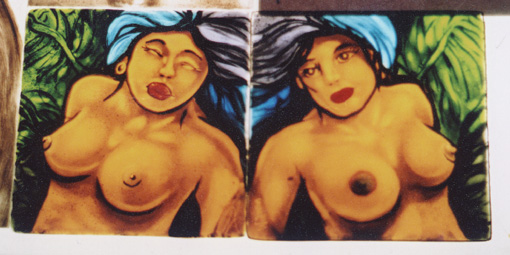
In this photo are several pieces Peter has on display in the studio, which feature the vitri-fusaille method and the amazing results that can be acheived through its application. He makes all the frames, too.
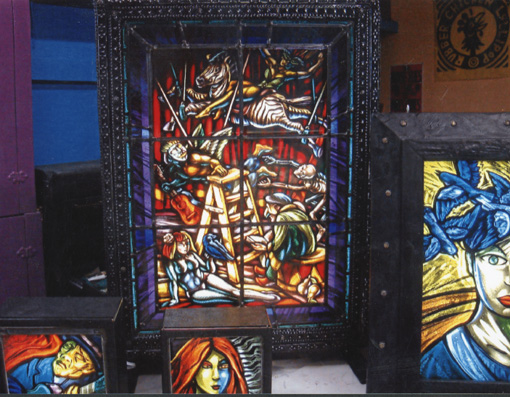
In this final picture, is a fusaille piece done by Raphael Schnepf, utilizing Peter's techniques, and all System 96 COE glass. But, Raphael's work take another step beyond two-layer fusing and then painting. He also fuses frit and other forms of System 96 glass products into his pieces, and instead of brush painting most of his paint work, he mostly uses the airbrush to apply his painted lines and shading. This piece was chosen for the 2008 cover of the System 96 Catalogue. The one below it, is one he did in January '09 with several new techniques used in its creation.

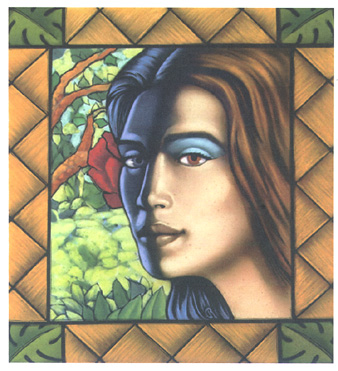
If this style of glass work intrigues you, as it does me, feel free to contact Peter or Raphael and ask about thier training in glass painting, fusing, and other things. Their contact information is on their respective pages on this website, or you can Google them or email me. -- Pat
Thomas P. "Pat" Jacobsen --
P.O. Box 791, Weimar, CA, 95736-0791, U.S.A.
Phone 530.637.5923. (8:00 AM - 5:00 PM, weekdays (PST) !!)
EMAIL: pjacobsen@millenniumartglass.com
(Last update:1.21.09)